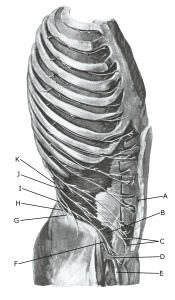Anatomy
 Numerous nerves break through the abdominal wall and send nerve branches to the abdomen, groin and thigh area. Nerves can be pinched where they break through the abdominal wall. The sciatic nerve in the buttock can be pinched between the ischial tuberosity (tuber ischiadicum) and the femur (trochanter minor)
Numerous nerves break through the abdominal wall and send nerve branches to the abdomen, groin and thigh area. Nerves can be pinched where they break through the abdominal wall. The sciatic nerve in the buttock can be pinched between the ischial tuberosity (tuber ischiadicum) and the femur (trochanter minor)
Nerves around the groin:
A. Umbilicus (navel)
B. M. obliquus internus abdominis
C. Rami cutanei anteriores n. intercostalis XII
D. Anulus inguinalis superficialis
E. Funiculus spermaticus
F. N. ilioinguinalis
G. N. iliohypogastricus (ramus cutaneus lateralis)
H. Ramus muscularis
I. N. iliohypogastricus
J. M. transversus abdominis
K. N. intercostalis XII
Cause of the problem
If a nerve branch is pinched (nerve entrapment), pain and sensory disturbances will occur in the area to which the nerve branch gives off sensory nerves. This could be the corresponding nervus cutaneus femoris lateralis (which is pinched just below the outer (lateral) part of the inguinal ligament) or the sciatic nerve, which can be pinched between the ischial tuberosity (tuber ischiadicum) and the femur (trochanter minor) as part of the so-called ischiofemoral impingement syndrome (Wu WT, et al. 2022).
Symptoms
Pain depends on which nerves are being pinched. If the lateral cutaneous femoral nerve is pinched, there is stinging, tingling and sometimes burning pain on the front or outside of the thigh, which worsens when the anterior thigh muscle is stretched. In ischiofemoral impingement syndrome, pinching of the sciatic nerve can often radiate down the back of the leg in addition to pain in the buttock (Wu, W-T et al., 2022).
With superficial nerve pinches, symptoms can often be provoked by pressure on the pinched nerve.
Examination
During the clinical examination, the bothersome symptoms (pins and needles) can usually be provoked by tapping the area where the nerve is pinched with a finger (Tinel’s test). In ischiofemoral impingement syndrome, symptoms are provoked by rotation of the hip. Applying a few millilitres of local anaesthetic to the area where the nerve is pinched should resolve the symptoms if the diagnosis is correct.
Anyone with suspected nerve entrapment where there is no steady progress on treatment should therefore have this done, as it can provide a definitive diagnosis and, in about 10%, can permanently eliminate the pain (Jacobs MLYE, et al. 2021).
Ultrasound and MRI scans are the most suitable tests to detect nerves (Wu, W-T et al., 2022), but nerves can be pinched without being recognised by the tests. If in doubt, referral to neurological examination is advisable.
The actual frequency of the diagnosis is debated among professionals.
Treatment
The condition is harmless even if sports activity is continued. Reduction in pain-inducing activity is advised and strength training of the abdominal muscles is not recommended. Tight trousers that press on the sore area should be avoided.
If the discomfort persists with no signs of improvement, short-term (7-10 days) medical treatment (NSAIDs) and injection of local anaesthetic and adrenal cortical hormone around the sore nerve may be tried. If the injection triggers only a few hours of recovery, surgery may be considered (Lee CH, Dellon AL. 2000), but is rarely necessary. More than 90% recover spontaneously.
Complications
Of course, you should consider whether the diagnosis is correct.
In particular, the following should be considered:
- Inflammation of the adductor of the thigh
- Inflammation of the pubic joint
- Inflammation of the abdominal muscle at the point of attachment on the pubic bone
- Stress fracture in the femoral neck
- Bursitis on the front of the hip joint
- Fluid accumulation in the joint
- Degenerative arthritis
- Brupture of the superficial hip flexor
- Rupture of the deep hip flexor
- Outer snapping hip
- Inner snapping hip
- Slipped disc
